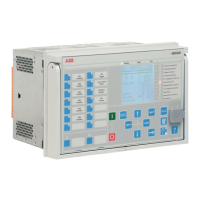Some of the measurement functions operate on two alternative measurement
modes: "DFT" and "RMS". The measurement mode is selected with the
X
Measurement mode
setting. Depending on the measuring function if the
measurement mode cannot be selected, the measuring mode is "DFT".
Demand value calculation
The demand values are calculated separately for each measurement function
and per phase when applicable. The available measurement modes are "Linear"
and "Logarithmic". The "Logarithmic" measurement mode is only effective for
phase current and residual current demand value calculations. The demand
value calculation mode is selected with the setting parameter Configuration >
Measurements > A demand Av mode. The time interval for all demand
value calculations is selected with the setting parameter Configuration >
Measurements > Demand interval.
If the
Demand interval
setting is set to "15 minutes", for example, the demand
values are updated every quarter of an hour. The demand time interval is
synchronized to the real-time clock of the protection relay. When the demand time
interval or calculation mode is changed, it initializes the demand value calculation.
For the very first demand value calculation interval, the values are stated as invalid
until the first refresh is available.
The "Linear" calculation mode uses the periodic sliding average calculation of the
measured signal over the demand time interval. A new demand value is obtained
once in a minute, indicating the analog signal demand over the demand time
interval proceeding the update time. The actual rolling demand values are stored
in the memory until the value is updated at the end of the next time interval.
The "Logarithmic" calculation mode uses the periodic calculation using a log10
function over the demand time interval to replicate thermal demand ammeters. The
logarithmic demand calculates a snapshot of the analog signal every 1/15 x demand
time interval.
Each measurement function has its own recorded data values. In protection relay,
these are found in Monitoring > Recorded data > Measurements. In the technical
manual these are listed in the monitored data section of each measurement
function. These values are periodically updated with the maximum and minimum
demand values. The time stamps are provided for both values.
Reset of Recorded data
initializes a present demand value to the minimum and
maximum demand values.
Value reporting
The measurement functions are capable of reporting new values for network
control center (SCADA system) based on various functions.
• Zero-point clamping
• Deadband supervision
• Limit value supervision
In the three-phase voltage measurement function VMMXU the
supervision functions are based on the phase-to-phase voltages.
However, the phase-to-earth voltage values are also reported with the
phase-to-phase voltages.
GOOSE is an event based protocol service. Analog GOOSE uses the
same event generation functions as vertical SCADA communication for
updating the measurement values. Update interval of 500 ms is used for
1MRS757644 H Measurement functions
620 series
Technical Manual
927

